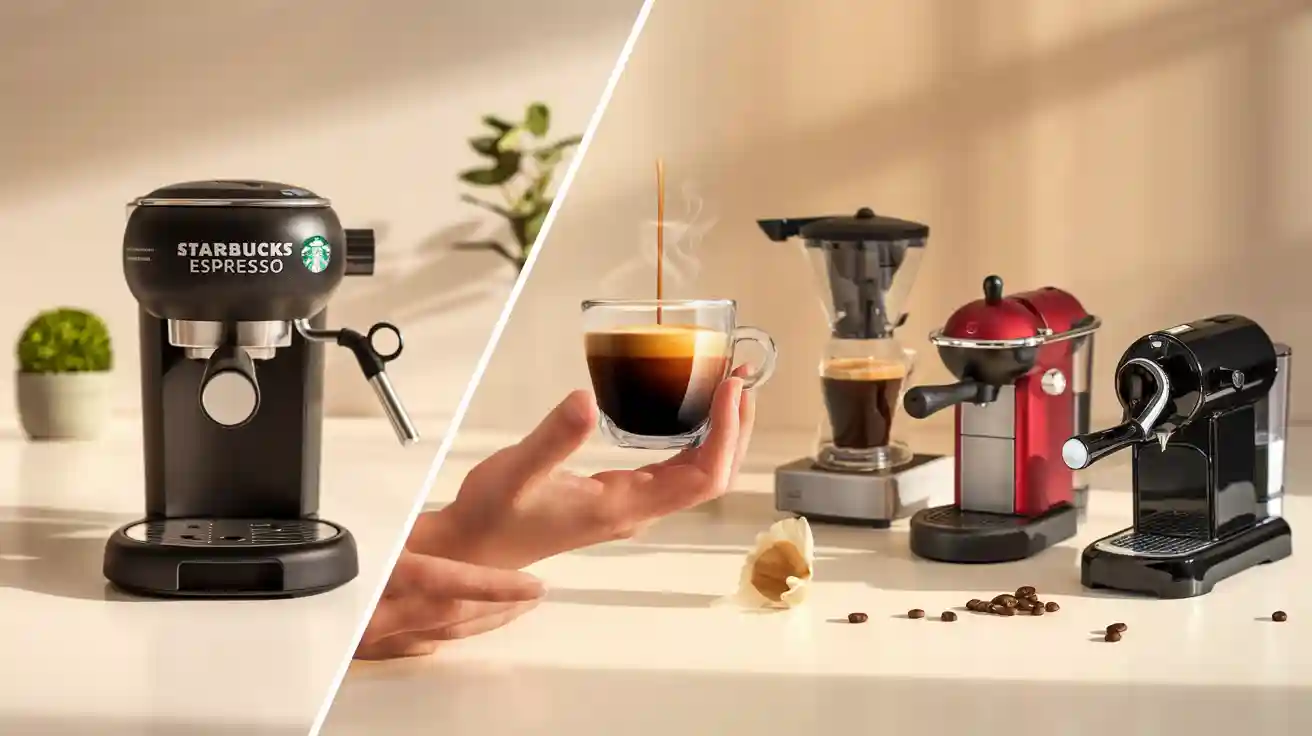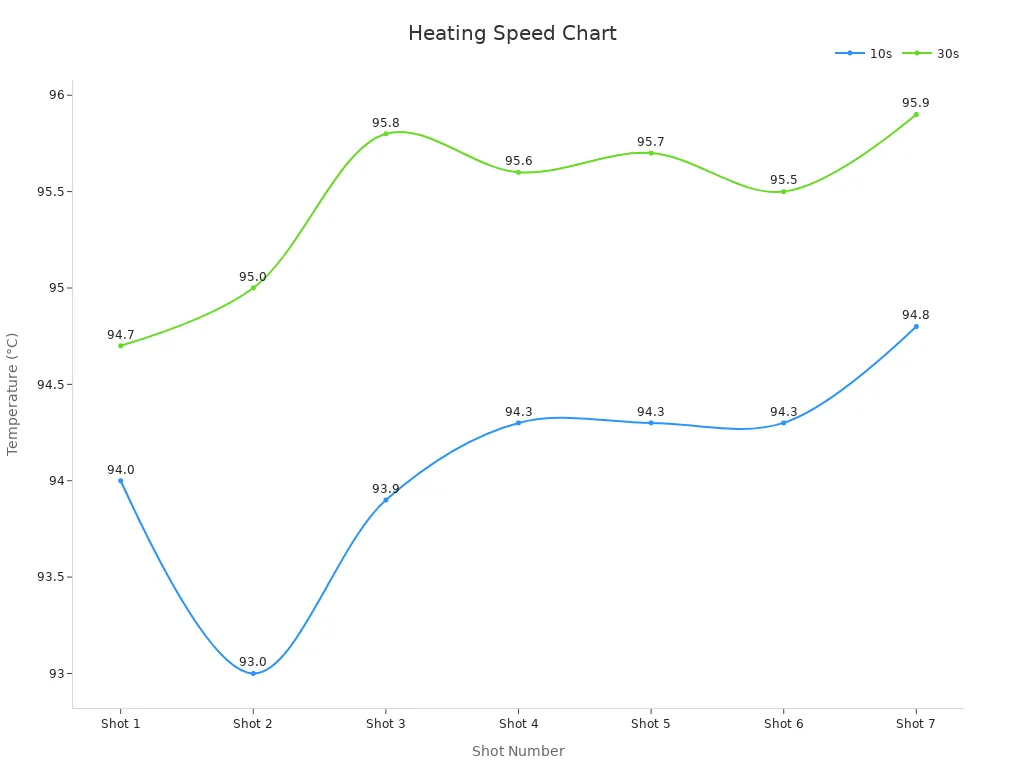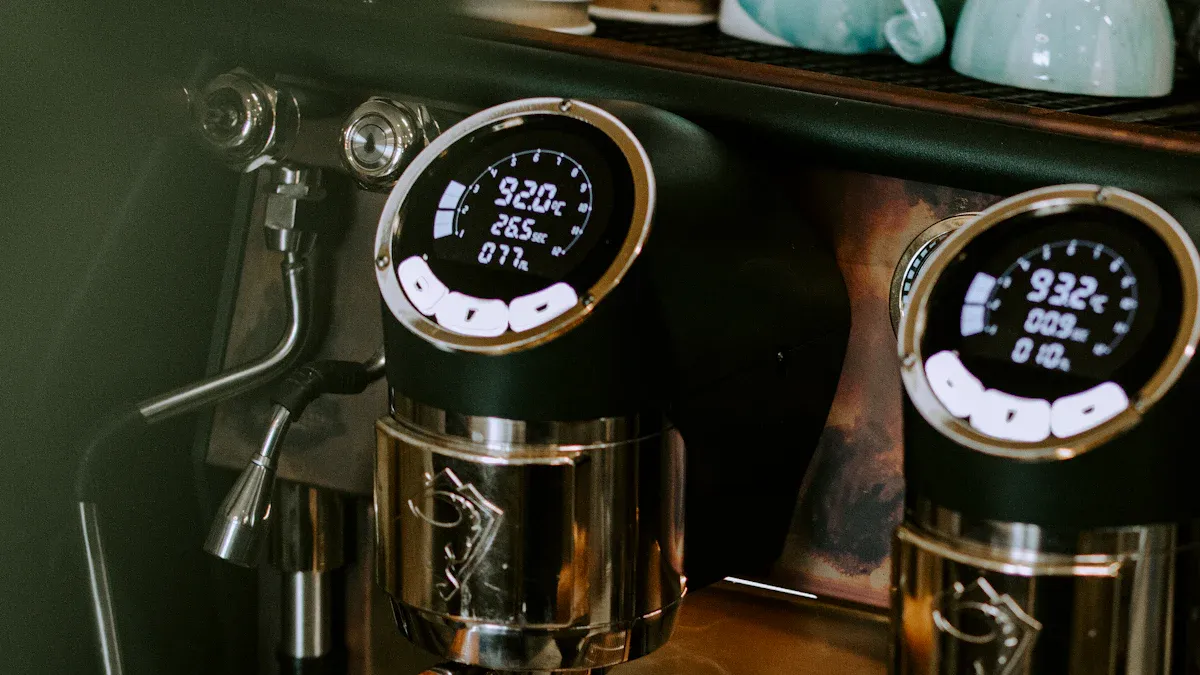
You will find that modern alternatives offer better value for most users in 2025. Rising demand for quick, high-quality espresso drinks means newer machines suit busy lifestyles. However, if you love the hands-on process and classic design, you might still enjoy the Starbucks Barista espresso machine experience.
Starbucks Barista Espresso Machine Performance vs. Modern Alternatives
Espresso Quality and Taste
When you compare espresso quality, you notice differences in flavor and extraction between the Starbucks Barista espresso machine and modern semiautomatic models. The Barista machine gives you a classic espresso taste. You control the grind, tamp, and timing, which lets you experiment with flavor. Many users enjoy the rich, bold flavor that comes from manual extraction. However, modern semiautomatic machines use advanced temperature controls and pressure systems. These features help you get more consistent flavor in every cup. You can taste the difference, especially if you like high-quality drinks with balanced acidity and sweetness. Modern machines often use pre-infusion and digital controls to improve extraction quality. This means you get a smoother, more complex flavor profile. If you want to make espresso-based drinks at home, you will find that modern alternatives deliver better flavor and quality with less effort.
Steaming and Frothing Capabilities
Steaming milk is important for lattes and cappuccinos. The Starbucks Barista espresso machine uses a single boiler. You must wait for the machine to switch from brewing to steaming. This process takes time and can affect the quality of your milk foam. Modern semiautomatic machines often have dual boilers or heat exchangers. These features let you brew espresso and steam milk at the same time. You get faster results and better consistency in your milk texture. The steam wands on new machines give you more control over frothing. You can create microfoam for latte art or thick foam for cappuccinos. The quality of steamed milk improves the flavor and mouthfeel of your drinks. If you want to make café-style drinks at home, you will appreciate the performance of modern machines.
Heating Speed and Consistency
Heating speed and temperature consistency play a big role in espresso extraction. The Starbucks Barista espresso machine uses older technology. You may notice longer wait times between shots and less stable temperatures. Modern semiautomatic machines use advanced thermoregulation systems. These systems help you get fast heat-up times and stable temperatures for every shot.
Temperature stability leads to better extraction and flavor in your espresso.
You can see the difference in laboratory tests. The table below shows how modern E61 dual boiler machines keep the temperature steady from shot to shot:
| Shot Number | Time After Start (s) | Temperature (°C) | Interval Since Previous Shot (min) |
|---|---|---|---|
| 1 | 10 | 94.0 | N/A |
| 1 | 30 | 94.7 | N/A |
| 2 | 10 | 93.0 | 6 |
| 2 | 30 | 95.0 | 6 |
| 3 | 10 | 93.9 | 2 |
| 3 | 30 | 95.8 | 2 |
| 4 | 10 | 94.3 | 2 |
| 4 | 30 | 95.6 | 2 |
| 5 | 10 | 94.3 | 2 |
| 5 | 30 | 95.7 | 2 |
| 6 | 10 | 94.3 | 2 |
| 6 | 30 | 95.5 | 2 |
| 7 | 10 | 94.8 | 2 |
| 7 | 30 | 95.9 | 2 |

Modern machines use a thermosyphon system to move heat quickly from the boiler to the group head. When you pull a shot, the system cools down, but it recovers fast. This quick recovery keeps the temperature steady for the next shot. You get better consistency and quality in your espresso extraction. Even with tools that may flatten the temperature curve, tests show that modern machines keep the temperature within 1 to 2 degrees Celsius. This level of consistency helps you make high-quality drinks every time.
Reliability and Durability: Best Espresso Machine for Long-Term Use

Build Quality Comparison
When you look for the best espresso machine, you want something that lasts. Many product reviews use both numbers and user stories to judge build quality. You often see star ratings and scores that show how strong a machine feels. Reviewers also talk about the materials used, like stainless steel or plastic. These details help you decide if a semiautomatic machine will hold up over time. Here are some ways experts measure build quality:
- Reviewers check for solid frames and heavy-duty parts.
- They compare how well machines resist scratches and dents.
- Some reviews track how machines perform after months of daily use.
- Trend reports show if certain models improve or decline in quality over the years.
You will notice that semiautomatic machines often score higher for build quality. They use fewer electronics, so there is less that can break. This makes them a top choice if you want the best espresso machine for long-term use.
Longevity and Common Failures
You want your espresso machine to last for years. The table below shows how different types compare for lifespan and common problems:
| Espresso Machine Type | Estimated Lifespan | Common Issues / Failure Causes | Maintenance Recommendations |
|---|---|---|---|
| Manual and Semiautomatic | 10 to 15 years (often longer with care) | Less prone to breakdowns due to fewer electronics | Regular cleaning, descaling, replacing seals/gaskets |
| Fully Automatic & Super Automatic | 5 to 10 years (can last longer with maintenance) | More electronic parts and moving components wear out | Frequent maintenance, descaling every 3-6 months, professional servicing as needed |
| Pod and Capsule Machines | 3 to 5 years | Less durable, harder to repair | Regular cleaning, mindful use, limited repair options |
You can make your semiautomatic machine last longer by cleaning it often and using filtered water. Watch for signs like leaks or strange noises. These can mean it is time to replace seals or descale the machine. If you want the best espresso machine for both quality and durability, a semiautomatic model gives you a strong balance. You get high quality, fewer breakdowns, and a machine that can serve you for many years.
Ease of Use and Maintenance: Which Offers More Value?
User Interface and Controls
You want an espresso machine that feels easy to use every day. The Starbucks Barista espresso machine uses simple buttons and knobs. You control each step, so you learn how to make espresso by hand. This style helps you understand the process, but it can feel tricky if you are new. Many people call it a good espresso machine for beginners because you get to practice and see results right away.
Modern machines often use digital displays and touch controls. A fully automatic espresso machine can guide you through each step. You press a button, and the machine does the rest. This saves time and reduces mistakes. If you want a quick cup before work, you will enjoy the speed and ease of these controls.
Tip: If you like to experiment, choose a machine with manual controls. If you want convenience, look for a fully automatic espresso machine.
Cleaning and Upkeep
Keeping your espresso machine clean helps it last longer. The Starbucks Barista espresso machine needs regular cleaning. You must rinse the portafilter, wipe the steam wand, and descale the boiler. These steps take a few minutes each day. Some users find this routine helps them care for their machine.
Modern machines often have cleaning alerts and automatic rinse cycles. A fully automatic espresso machine can remind you when to clean or descale. Some models even clean themselves with one touch. This feature saves time and makes maintenance easier, especially for busy families.
| Feature | Starbucks Barista | Modern Alternatives |
|---|---|---|
| Manual Cleaning Needed | Yes | Sometimes |
| Cleaning Alerts | No | Yes |
| Self-Cleaning Option | No | Yes (some models) |
Parts and Support Availability in 2025
Replacement Parts for Starbucks Barista Espresso Machine
You may find it harder to get replacement parts for the starbucks barista espresso machine in 2025. This machine is no longer in production, so you cannot order new parts from the original manufacturer. You might need to look for third-party suppliers or online marketplaces. Some parts, like portafilters and gaskets, remain easy to find because they fit other machines. Other parts, such as boilers or electronic switches, can be rare and expensive.
Tip: Always check the compatibility of parts before you buy. Some sellers list parts that do not fit every version of the machine.
Here is a quick guide to common parts and their availability:
| Part Type | Availability | Typical Source |
|---|---|---|
| Portafilter | Good | Online retailers |
| Gaskets/Seals | Good | Coffee parts stores |
| Boiler | Limited | Used/refurbished only |
| Switches/Knobs | Limited | Specialty sellers |
Customer Support and Community Resources
You will not get official customer support for the starbucks barista espresso machine. The company stopped offering help for this model years ago. You can still find help from online communities and forums. Many users share repair tips, cleaning guides, and troubleshooting steps. YouTube videos can show you how to fix common problems.
If you want fast answers, try searching for your issue in coffee forums. You can also post questions and get advice from other owners. These resources help you keep your machine running, even when official support is gone.
Price and Value for Money: Choosing the Best Espresso Machine
Upfront Cost Comparison
When you shop for the best espresso machine, you see a wide range of prices. The Starbucks Barista espresso machine often appears on the used market. You might find it for $150 to $300. This price can look affordable if you want a classic machine. Modern alternatives come in many types. Entry-level models start at $200. Some premium machines cost over $1,000. You pay more for features like digital controls, dual boilers, and better steam wands. If you want an affordable option, look for new machines with basic features. These models give you good value without a high price tag.
Here is a quick price guide:
| Machine Type | Typical Price Range |
|---|---|
| Starbucks Barista | $150 – $300 (used) |
| Entry-Level Modern | $200 – $400 |
| Premium Modern | $700 – $1,500+ |
Tip: You do not need to buy the most premium model to get great value. Many affordable machines offer strong performance for home use.
Long-Term Costs and Investment
You should think about more than just the upfront price. Long-term costs include maintenance, repairs, and upgrades. The Starbucks Barista espresso machine may need rare parts. These parts can be expensive and hard to find. Modern machines often come with warranties and easy-to-find parts. This makes them more affordable to maintain over time.
If you choose a premium machine, you might pay more at first. However, you get better durability and support. Consumer reports show that technology investments, like mobile ordering systems, require ongoing maintenance costs of 5-10% of the initial price each year. Espresso machines follow a similar pattern. You spend money on cleaning supplies, water filters, and sometimes professional servicing. Over five years, an affordable machine with easy maintenance can save you money. You get more value from a machine that lasts and stays reliable.
Remember, the best espresso machine is the one that fits your budget and gives you the most value for your needs.
User Experiences and Common Issues with Home and Commercial Espresso Machines
Typical User Feedback
When you use a semiautomatic or commercial espresso machine, you often notice how much control you have over the flavor of your drinks. Many users say they enjoy the hands-on process. You can adjust the grind, tamp, and timing to get the best extraction. People who choose a commercial espresso machine for home use often mention the high quality and consistency in every cup. You may find that semiautomatic machines let you experiment with different beans and recipes. This helps you discover new flavors and improve your skills.
Users also talk about the learning curve. At first, you might struggle to get the right extraction or milk texture. Over time, you learn how to make drinks with better flavor and quality. Many people feel proud when they master their machine. If you want to choose a commercial espresso machine, you should read reviews and watch videos. These resources help you understand what to expect.
Known Problems and Fixes
You may face some common issues with both home and commercial espresso machines. One problem is uneven extraction, which can affect flavor and quality. To fix this, you should check your grind size and tamp pressure. Another issue is poor consistency in temperature or pressure. Regular cleaning and maintenance help keep your semiautomatic machine running well.
If you choose a commercial espresso machine, you might see leaks or worn gaskets after heavy use. You can replace these parts easily. Sometimes, you get weak flavor because of old beans or clogged filters. Always use fresh beans and clean your machine often. The table below shows quick fixes for common problems:
| Problem | Quick Fix |
|---|---|
| Uneven extraction | Adjust grind and tamp |
| Weak flavor | Use fresh beans, clean filters |
| Leaks | Replace gaskets or seals |
| Poor consistency | Regular maintenance |
Tip: Keep a maintenance log to track cleaning and repairs. This helps you keep your espresso machine in top shape.
You get the best value in 2025 from modern machines. Choose the Starbucks Barista espresso machine if you enjoy hands-on brewing. Most people prefer modern alternatives for speed and convenience. For smart espresso machine recommendations, think about your daily routine and how much control you want.
FAQ
Can you use a commercial espresso machine at home?
Yes, you can use a commercial espresso machine at home. You need enough space and a strong power source for the best results.
What is the main difference between a home and a commercial espresso machine?
A commercial espresso machine makes more drinks quickly. It uses stronger parts and lasts longer in busy places like cafes or restaurants.
How often should you clean your espresso machine?
You should clean your espresso machine every day. Regular cleaning keeps your drinks tasting fresh and helps your machine last longer.


